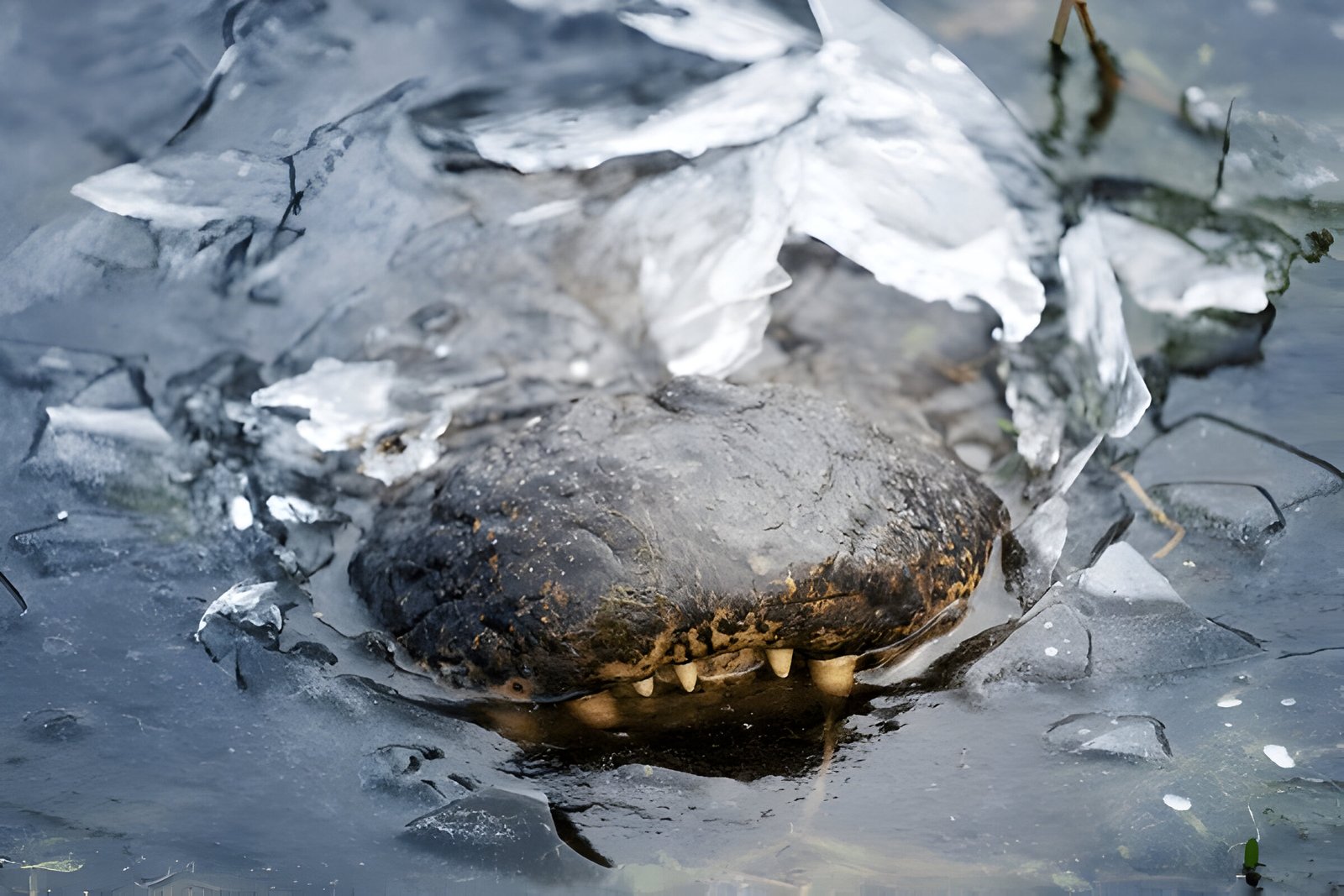Image Credit: ShutterStock
As winter descends upon North Carolina, a remarkable phenomenon unfolds in the state’s swamps and waterways. Frozen alligators, their snouts poking through icy surfaces, have captured the attention of locals and scientists alike. This unusual sight raises questions about how these cold-blooded reptiles manage to survive in freezing temperatures, challenging our understanding of their adaptability and resilience.
The survival techniques of frozen alligators in North Carolina showcase a fascinating process called brumation. This state of dormancy allows American Alligators to endure harsh winter conditions by slowing their metabolic rate and becoming lethargic. As Arctic air sweeps across regions like Ocean Isle Beach, these prehistoric creatures employ unique adaptations to thaw out when waters freeze. This article explores the physiological changes alligators undergo during brumation, their survival strategies in icy environments, and the broader implications for cold-blooded reptiles in changing climates.
Understanding Brumation in Alligators
Brumation, a process akin to hibernation, is a crucial survival strategy for alligators in North Carolina during winter. This state of dormancy allows these cold-blooded reptiles to cope with freezing temperatures and food scarcity. Unlike hibernation, where animals enter deep sleep, brumating alligators experience a slowdown in metabolism and movement. They remain somewhat active, occasionally emerging to drink water and bask in the sun on warmer days.
Alligators initiate brumation when water temperatures drop below 70°F (21°C). As ectothermic creatures, they rely on external heat sources to regulate their body temperature. During brumation, their metabolic rate decreases significantly, enabling them to conserve energy and survive on stored fat reserves. This adaptation allows alligators to endure harsh environmental conditions for 4-5 months, typically from November to late February, until warmer temperatures and prey return.
Physiological Changes During Brumation
During brumation, alligators undergo remarkable physiological changes to survive harsh winter conditions. Their metabolic rate decreases dramatically, allowing them to conserve energy and endure long periods without food. Heart rate plummets from 30-40 beats per minute to an astonishing 3-10 beats per minute, the lowest among vertebrates. Breathing rates also decline significantly, from 6-10 breaths per minute to just 1-2, with alligators capable of holding their breath for up to an hour.
As ectothermic creatures, alligators’ body temperature drops to match their surroundings, further reducing their metabolic needs. This process triggers autophagy, a cellular catabolic process that helps maintain energy homeostasis during metabolic stress. Research has identified the expression of autophagy-related genes and proteins in alligator liver tissue, highlighting the complex physiological adaptations at play.
Despite their lethargic state, brumating alligators remain somewhat active, occasionally emerging to drink water and bask in the sun on warmer days. This sporadic activity, combined with nutrient scarcity, may strain their nutrient reserves, making autophagy crucial for survival during the 4-5 month brumation period.
Survival Techniques of Frozen Alligators
Alligators in North Carolina have developed remarkable survival techniques to endure freezing temperatures. These cold-blooded reptiles instinctively push their snouts above the water’s surface as it freezes, creating breathing holes in the ice. This adaptation allows them to continue respiring even when their bodies are immobilized by the frozen water. During this period of brumation, alligators experience a significant slowdown in their physiological processes. Their heart rate drops to an astonishing three beats per minute, and they become lethargic to conserve energy. Despite appearing frozen, these resilient creatures remain somewhat active, occasionally emerging on warmer days. This survival strategy showcases the alligator’s ability to adapt to harsh environmental conditions, demonstrating nature’s ingenuity in the face of extreme challenges.
Conclusion
The remarkable survival techniques of frozen alligators in North Carolina shed light on the incredible adaptability of these ancient reptiles. Their ability to endure harsh winter conditions through brumation showcases nature’s ingenuity in the face of environmental challenges. The physiological changes these alligators undergo, including dramatic decreases in heart rate and metabolism, highlight the complex mechanisms at play to conserve energy during prolonged periods of cold.
These findings have an impact on our understanding of cold-blooded reptiles and their resilience in changing climates. The alligators’ capacity to thrive in freezing temperatures offers valuable insights to analyze the potential effects of climate change on similar species. As we continue to explore these fascinating adaptations, we gain a deeper appreciation for the diverse strategies that animals employ to survive in extreme conditions.
Also Read: fox sounds at night
FAQs
1. How do alligators manage to endure the cold winter months in North Carolina?
Alligators in North Carolina, and even in Texas, cope with cold snaps by letting their bodies hang in pond waters that freeze around them. They keep only their snouts and front teeth above the ice surface, which allows them to breathe while they wait for the ice to melt.
2. Can alligators survive if they become frozen?
Yes, alligators can survive freezing conditions. They undergo a process called brumation, which is similar to hibernation but for reptiles. This process allows them to live through cold weather as long as their nostrils remain above the water surface, according to the U.S. Forest Service.
3. What is the lowest temperature an alligator can withstand?
Alligators are capable of surviving in temperatures as low as 40°F. They achieve this by entering brumation, a state of reduced physiological activity that helps them endure freezing conditions.
4. Where do alligators retreat to during freezing weather?
When temperatures fall below around 70 degrees, alligators stop feeding and become dormant as temperatures drop further below 55 degrees. During the colder winter months, they often stay in burrows or dens which they construct near alligator holes or open bodies of water.
























[…] Read More About: How Frozen Alligators in North Carolina Survive Winter […]